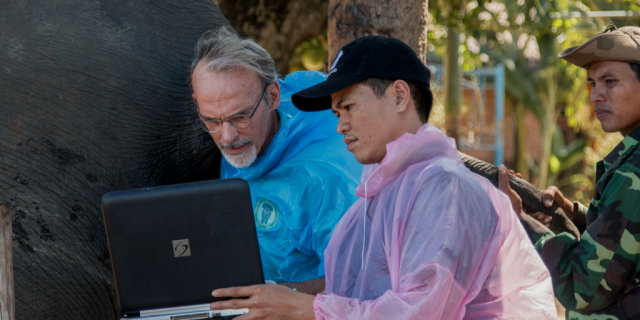
Vietnam’s wild elephant population has dropped from over 2,000 animals to less than 100 in 20 years, making the country’s 60 or so captive elephants vital to preserving the genetic lines of this critically endangered species.
Dr. Willem Schaftenaar, Veterinary Advisor to the European Studbook of Elephants, has been assisting the Đăk Lăk Elephant Conservation Centre (ECC) in identifying female elephants suitable for breeding. With the help the Animals Asia Foundation and a Sonosite Edge, Dr. Schaftenaar and the ECC are working with owners to establish a breeding programmeme for captive animals and help lead the Wild Elephant off the endangered species list. Dr. Schaftenaar recently discussed his work in Vietnam with us.
I was originally invited to Vietnam by the Animals Asia Foundation in June 2015. At that time, approximately 60 elephants were still used in the tourism industry for rides, but none of these were used for breeding. The major challenge is that, once a female elephant or ‘cow’ has calved, she can no longer be used for tourist rides.
Although there are plenty of examples in other Asian countries where owners have found other ways to generate income from their animals, this does require some education and support. The ECC aims to develop a captive breeding programmeme that will avoid the extinction of elephants in Vietnam, working with the owners of these animals to develop a sustainable and economically viable future.
During my initial visit, we performed health assessments on 40 captive elephants across Đăk Lăk province, identifying eight cows under 40 years of age who could potentially be bred from. The ECC vet – working in collabouration with a private hospital labouratory in Ho Chi Minh City – then monitored the plasma progesterone levels of these eight animals through weekly blood checks, confirming that seven still had an oestrous cycle.
I then visited the ECC again in November 2016, this time equipped with a FUJIFILM Sonosite Edge ultrasound system. Ultrasound has been an important tool in my daily zoo practise for over 20 years, and I was grateful to FUJIFILM Sonosite for providing a highly portable and robust instrument for this trip. In three days, I visited all seven of these animals – plus another one identified later – and used ultrasound to assess the uterus of each cow for tumours, which are a common problem in Asian elephants that have not produced offspring for long periods.
Ultrasound was invaluable for this work, as it is the only practical way to assess the uterus in such large animals. Once a cow becomes pregnant, it is also useful in the early stages of pregnancy – from eight to 20 weeks – to monitor the embryo. Having a system with good image quality is vital for this as, even at this stage, it is quite deep within the mother. And because you’re working with elephants – which rarely stand still – you also need an instrument that is both highly portable and relatively robust, making Sonosite systems ideal.
Although we found a few small tumours in two of the elephants during this assessment, which may reduce the chance of them becoming pregnant, all of them appeared fit enough for producing offspring. Following our visit, the ECC team continued to monitor the oestrous cycle of these animals, helping to identify when a bull elephant should be brought to the cow for mating. One elephant has already become pregnant using this approach, and will be moved to the ECC towards the end of the pregnancy, allowing her to give birth away from the hectic tourist environment.
Ultrasound will again be invaluable at this stage, as the calf is so deep inside the mother that sonography is the only way to visualise when it has entered the cervix or vagina. Hopefully it will not be too late for this group of captive elephants in Vietnam, allowing the ECC to establish a breeding programmeme and provide a better future for these impressive animals and their offspring.
Learn More about POC Ultrasound for Large Animals
Sonosite machines are battery powered, portable, and built tough to be able to scan some of the world's biggest animals.

